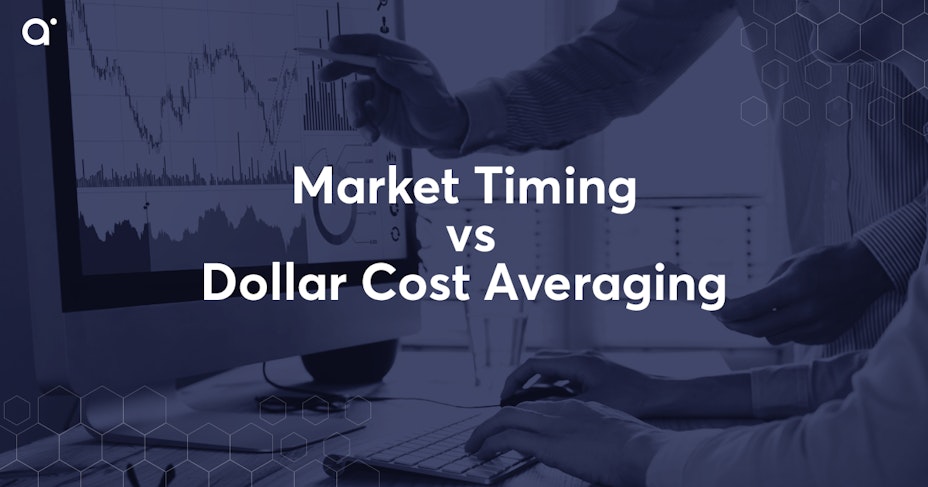Dollar cost averaging (DCA) vs market timing
- 5 minute read

With the bear market in full swing, some of you have probably googled for the best crypto exit strategy . Others were anticipating this moment, as they finally see an opportunity to invest. But what is the best tactic in the current bear market? Some want to pinpoint the best moment and try to time the market/bottom; others firmly believe in the boring (but effective) method of dollar-cost averaging. So, let’s take a look at the pros and cons of both investment methods.

Timing the market
Whether you are trading stocks or crypto, timing the market is not easy. If it was, everybody would be doing it, anticipating real bottom of the current dip. That is why professional investors and analysts that are correct are so hard to find. In the world of stocks, these people receive a hefty salary and rightly so. They need to understand the products and market like the back of their hand. Predicting the future is worth a fortune, sometimes literally. So, what do we mean when we say timing the market? Simply put, it means trying to pinpoint the exact moment on when to enter or exit the market. TLDR: buy low, sell high. In the current market, investors are trying to time the moment Bitcoin reaches its true bottom. This is done through experience, technical analysis and sometimes artificial intelligence and trading bots. The advantage of this strategy is that if you are correct, you can earn way more than with any other investment strategy. The downside? It’s not easy, especially in a relatively new market such as crypto. But let’s be honest, everybody has tried it. It is after all, the bulk of investment content in crypto media.
What is DCA (Dollar-cost averaging)?
Dollar-cost averaging, commonly known as DCA, is a safe investment strategy where you divide up the amount you are willing to invest across periodic purchases over time. This way you have to worry less about volatility when investing in a digital asset. You buy the cryptocurrency regardless of the price and systematically (for example every month). Simply put, you don’t time the market, you just buy the regular amount at a regular time. This can be either a set amount or a set percentage.
With DCA you don’t have to worry about counter-productive decisions that are based on fear or greed. DCA is also a solid plan for those who are still new to the world of cryptocurrency. New investors do not know the market and do not know the product. By having a basic DCA plan, you can test out the waters and see what a regular investment yields. Sure, dollar-cost averaging is not a golden rule that will lead to definitive success. However, this strategy can prevent becoming too greedy, or buying to late, while still taking profits from time-to-time. The tactic also works the other way around in case you need a basic (but solid) crypto exit strategy. The downside of DCA? Some might think it’s too passive. DCA’ing during a bull market might mean you miss capital gains while the iron is hot.
To summarize:
- With dollar-cost averaging (DCA) you systematically invest equal amounts, divided over regular intervals, regardless of the price at that moment.
- With DCA you reduce the impact of volatility regarding the price of a digital asset.
- This prevents traders from making a badly timed investment, as they are not dependent on a specific moment.
What investment tactic is better? Timing the market or dollar-cost averaging?
Both tactics have their pros and cons. Timing the market might yield bigger gains, but also brings bigger risks. For beginners we recommend the dollar-cost averaging tactic as it mitigates the risk, but also works better on a trader’s psychology. Trades that are based on fear and greed can have devastating effects on newcomers and veterans alike. In the long run, traders that use the DCA strategy bet on simplicity and protect themselves from certain temptations.
Another possibility is, of course, the tactic of combining both strategies. To test the waters, you start off with a dollar-cost averaging schedule. Once you see an enormous uptick in the market, you might adjust your schedule a bit and might commit a bigger chunk to invest. When you have made a higher profit than expected, you can invest the surplus in a different project by trying to time the market. No need to go all in. Or use the profits to accelerate your DCA over a certain set of months. Once you have hit your goal, you could always revert to your normal schedule. You could also do it the other way around if the market sentiment is extremely negative or use this tactic when selling coins. Multiple tactics are viable if you set goals and expectations for yourselves. It’s nice in a bull market if everything goes up, but experienced traders should always have a contingency plan for worst case scenarios!


